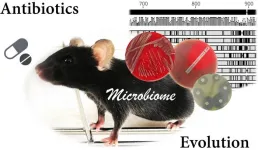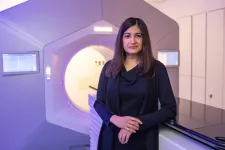(Press-News.org) A successful long-term experiment with live hogs indicates Nebraska scientists may be another step closer to achieving a safe, long-lasting and potentially universal vaccine against swine flu.
The results are not only important to the pork industry, they hold significant implications for human health. That’s because pigs act as “mixing vessels,” where various swine and bird influenza strains can reconfigure and become transmissible to humans. In fact, the 2009 swine flu pandemic, involving a variant of the H1N1 strain, first emerged in swine before infecting about a fourth of the global population in its first year, causing nearly 12,500 deaths in the United States and perhaps as many as 575,000 worldwide, according to the Centers for Disease Control and Prevention.
“Considering the significant role swine play in the evolution and transmission of potential pandemic strains of influenza and the substantial economic impact of swine flu viruses, it is imperative that efforts be made toward the development of more effective vaccination strategies in vulnerable pig populations,” said Erika Petro-Turnquist, a doctoral student and lead author of the study recently published in Frontiers in Immunology.
Petro-Turnquist is advised by Eric Weaver, associate professor and director of the Nebraska Center for Virology. Weaver’s laboratory is spearheading an effort that uses Epigraph, a data-based computer technique co-developed by Bette Korber and James Theiler of Los Alamos National Laboratory, to create a more broad-based vaccine against influenza, which is notoriously difficult to prevent because it mutates rapidly.
Pork producers currently try to manage swine flu by using commercially available vaccines derived from whole inactivated viruses and weakened live viruses. As of 2008, about half of the vaccines in use in the United States were custom-made for specific herds — an expensive, time-consuming and not very effective strategy because of the rapidity with which swine influenza evolves.
The Epigraph algorithm enables scientists to analyze countless amino acid sequences among hundreds of flu virus variants to create a vaccine “cocktail” of the three most common epitopes — the bits of viral protein that spark the immune system’s response. It could be a pathway to a universal flu vaccine, which the National Institutes of Health defines as a vaccine that is at least 75% effective, protects against multiple types of influenza viruses for at least one year and is suitable for all age groups.
“The first epitope looks like a normal influenza vaccine gene, the second one looks a little weird and third is more rare,” Weaver said. “We’re reversing the evolution and bringing these sequences that the immune system recognizes as pathogens back together. We’re computationally re-linking them and that’s where the power of this vaccine is coming from, that it provides such good protections against such a wide array of viruses.”
In another strategy to heighten effectiveness, the vaccine is delivered via adenovirus, a common virus that causes cold-like symptoms. Its use as a vector triggers additional immune response by mimicking a natural viral infection.
Two years ago, Weaver’s team published initial results in the journal Nature Communications, based on tests in mice and pigs. Those findings indicated the Epigraph-developed vaccine yielded immune response signatures and physiological protection against a much wider variety of strains than a widely used commercial vaccine and wildtype flu strains.
The follow-up study is apparently the first longitudinal study comparing the onset and duration of an adenovirus-vectored vaccine with that of a whole inactive virus vaccine. Petro-Turnquist and Weaver, along with Matthew Pekarek, Nicholas Jeanjaquet and Hiep Vu of the Department of Animal Science, Cedric Wooledge of the Office of Research and Economic Development and David Steffen of the Nebraska Veterinary Diagnostic Center, observed 15 Yorkshire cross-bred female pigs over a period of about six months, the typical lifespan of a market hog.
One group of five received the Epigraph vaccine, a second group of five received a commercial whole inactive virus vaccine, and a third group of five received a saline solution to serve as the control group. The pigs received their initial vaccination at three weeks of age and a booster shot three weeks later. Their antibody levels and T-cell responses were measured weekly for the first month and every 30 days thereafter. At six months of age, they were exposed to a strain of swine flu divergent from those directly represented in the vaccine.
The pigs that received the Epigraph vaccine showed more rapid and long-lasting antibody and T-cell responses to the vaccines. After exposure to the swine flu virus, the Epigraph-vaccinated hogs showed significantly better protection against the disease — less viral shedding, fewer symptoms of infection and stronger immune system responses.
“Those pigs weighed about five pounds when we vaccinated them and by the end of the study, six months later, they were over 400 pounds,” Weaver said. “It’s kind of amazing that this vaccine would maintain itself over that rate of growth. It continues to expand as the animal grows.”
Weaver’s team continues to pursue the research, with next steps including larger studies and possibly a commercial partnership to bring the vaccine to market.
“The more times we do these studies, the more confident we get that this vaccine will be successful in the field,” Weaver said.
END
Nebraska scientists closing in on long-lasting swine flu vaccine
2023-06-06
ELSE PRESS RELEASES FROM THIS DATE:
Bubble, bubble, more earthquake trouble? Geoscientists study Alaska's Denali fault
2023-06-06
LOGAN, UTAH, USA -- The 1,200-mile-long Denali Fault stretches in an upward arc from southwestern Alaska and the Bering Sea eastward to western Canada’s Yukon Territory and British Columbia. The long-lived and active strike-slip fault system, which slices through Denali National Park and Preserve, is responsible for the formation of the Alaska Range.
“It’s a big, sweeping fault and the source of a magnitude 7.9 earthquake in 2002, that ruptured more than 200 miles of the Denali Fault, along with the Totschunda Fault to the east, causing significant damage to remote villages and central Alaska’s infrastructure,” says Utah State University ...
Movement symptoms in dystonia are caused by spinal cord dysfunction
2023-06-06
Many neurological conditions that involve involuntary muscle contractions have long been considered as diseases of the brain. However, both the brain and the spinal cord contain many nerve cells associated with movement.
The research, published in Science Translational Medicine, used state-of-the-art mouse genetics to distinguish whether the brain or spinal cord was responsible for the disorganisation of movement experienced by dystonia patients.
Focusing on the most common inherited form of dystonia called DYT1, UCL scientists confined a genetic mutation to the spinal cord of the ...
Why are dog breeds with innate diseases popular?
2023-06-06
Flat-faced dogs, such as French and English Bulldogs, are extremely popular despite suffering from severe innate diseases. Hungarian researchers have attempted to uncover the explanation for this paradox. In the end, they concluded that although enthusiasts of flat-faced dogs are aware of the health issues and strive to provide the best for their dogs, they are likely to normalize health problems.
The French and English Bulldogs are among the most popular breeds in both the United States and Europe, but Pugs ...
Nursing home dementia residents’ care linked to majority presence, UC Irvine-led study finds
2023-06-06
Irvine, Calif., June 6, 2023 — The quality of care for nursing home residents with Alzheimer’s disease and related dementias is best when they are in the majority, but most facilities also accommodate a heterogeneous population, where specialized staff training is limited, according to a study led by the University of California, Irvine.
“Recognizing and managing the complex medical conditions and behavioral symptoms of residents with ADRD require enhanced knowledge among staff. These findings raise significant concerns regarding the level of care and quality of life for the majority of these people, highlighting ...
SRF operations earns certification to ensure customer satisfaction
2023-06-06
NEWPORT NEWS, VA – An important certificate now hangs on the wall of the Superconducting Radiofrequency Operations group at the U.S. Department of Energy’s Thomas Jefferson National Accelerator Facility.
SRF Operations builds cryomodules and other particle accelerator parts for the lab’s very own Continuous Electron Beam Accelerator Facility (CEBAF), a DOE Office of Science user facility. The group also supports user facilities at other DOE labs, including SLAC National Accelerator Laboratory and Oak Ridge National Laboratory. This piece of paper represents the department’s dedication to supplying ...
Two new studies identify promising pathways to treat chronic COVID-19
2023-06-06
Philadelphia, June 6, 2023 – Early studies of COVID-19 focused on the acute phase of the disease. However, attention has now turned to the long-term consequences of the disease, which are also significant causes of morbidity and mortality. Two studies reported in The American Journal of Pathology, published by Elsevier, seek to understand the drivers of the chronic and sometimes progressive phase of the disease and identify possible pathways for drug treatment.
The COVID-19 pandemic has highlighted ...
How the gut microbiome responds to antibiotics
2023-06-06
Each person's gut microbiome contains a specific community of microorganisms that normally remains stable for years. However, it can be thrown off balance by factors such as dietary changes, infections or medications. Antibiotics in particular have a strong influence on the microbiome. In response, microorganisms employ various resistance mechanisms, with individual bacterial populations evolving through selection of antibiotic-resistant variants. Yet, the extent and mechanisms of these processes and their impact on the ecology of the microbial community are ...
New study finds that women and underrepresented groups experience higher rates of sexual harassment, cyber incivility and negative workplace climate in academic medicine
2023-06-06
(Atlanta – June 6, 2023) – A new study led by Winship Cancer Institute of Emory University researcher Reshma Jagsi, MD, DPhil, has found that women, racial and ethnic minorities and individuals identifying as lesbian, gay, bisexual, transgender and queer are disproportionately affected by workplace mistreatment in academic medicine, and this mistreatment negatively impacts their mental health.
The study, which was published today in the Journal of the American Medical Association, looked specifically at three aspects of workplace mistreatment in academic medicine – sexual harassment, cyber incivility and negative workplace climate – and whether they differ by ...
Researchers target proteins, pathways behind congenital heart disease
2023-06-06
CHAPEL HILL, N.C. – Researchers at the UNC School of Medicine, UNC McAllister Heart Institute, and the UNC Lineberger Comprehensive Cancer Center characterized the expression of thousands of cardiac proteins during eight critical stages of embryonic heart development.
This research, published in Development Cell, will provide scientists with much-needed information to identify biological causes for congenital heart disease, or CHD.
“We now have a foundational data set that shows how protein dynamics change in normal heart development,” said first ...
New push will digitize records of African plants held in herbaria and museums across the US
2023-06-06
LAWRENCE — Over the past few decades, herbaria and museums worldwide have created digital data records documenting millions of specimens in their holdings. The benefits of digitizing the contents of natural history museums and research institutions flow to the public and researchers worldwide.
Now, through a group of related grants from the National Science Foundation, researchers are systemically digitizing more than a million specimens of plants from across tropical Africa held at 20 institutions throughout the United States. The tropical African plant specimens — documenting some of ...








